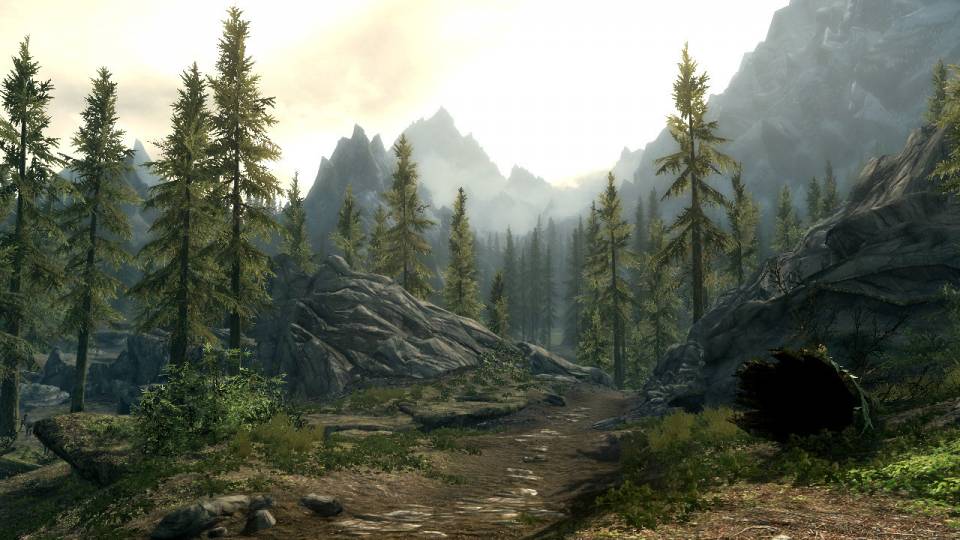Just to state it upfront, Skyrim still looks very much like the Elder Scrolls games you know and love. Bethesda has been talking all kinds of game lately about working with a new engine and improving its dialogue system and stuff like that--and yes, the graphics and dialogue look noticeably better, among many other obvious improvements--but the fundamental look, sound, and feel of Skyrim will be unmistakably familiar to anyone who spent a few (or a few hundred) hours traipsing around the world of Oblivion.
I got to see an hour-long demo of Skyrim last week, driven by Elder Scrolls big cheese Todd Howard. An hour is a long time to look at any game, but an hour with one this dense with atmosphere and activity yielded so much information I barely know where to begin. Let's just itemize the important parts and go from there, shall we?
The World
Skyrim takes place in a rugged northern environment skewered by towering, craggy peaks covered with snow. Given that setting, it's not surprising that most of the people you encounter look sort of like vikings, and the architecture and surroundings have a distinctly Nordic feel to them. The province of Skyrim is about the same size as Oblivion's Cyrodiil, but Howard mentioned that the presence of so many impassable mountains will direct and govern your travels in a way that Oblivion's gentler terrain did not. Skyrim is broken up into nine "holds" (similar to counties), five of which contain larger cities. It's a nice touch that you can pull the camera out to a map view--which is actually just a sky-high perspective on the existing world geometry--to get a quick and evocative sense of how Skyrim is laid out and just how big everything is.

But Bethesda is also working to make the consequences of your world interactions more dynamic and fluid. For all the semblance of life in its residents, Oblivion still had a stilted feel to it, like all of the characters were locked into walking along rigid, invisible tracks. By contrast, many of Skyrim's key characters, such as quest-givers, will act more dynamic and in some cases will even be somewhat replaceable. The sample quest Howard showed us involved a shopkeeper who wanted the player to pursue a group of thieves into the mountains and retrieve a precious artifact they'd stolen from the shop.
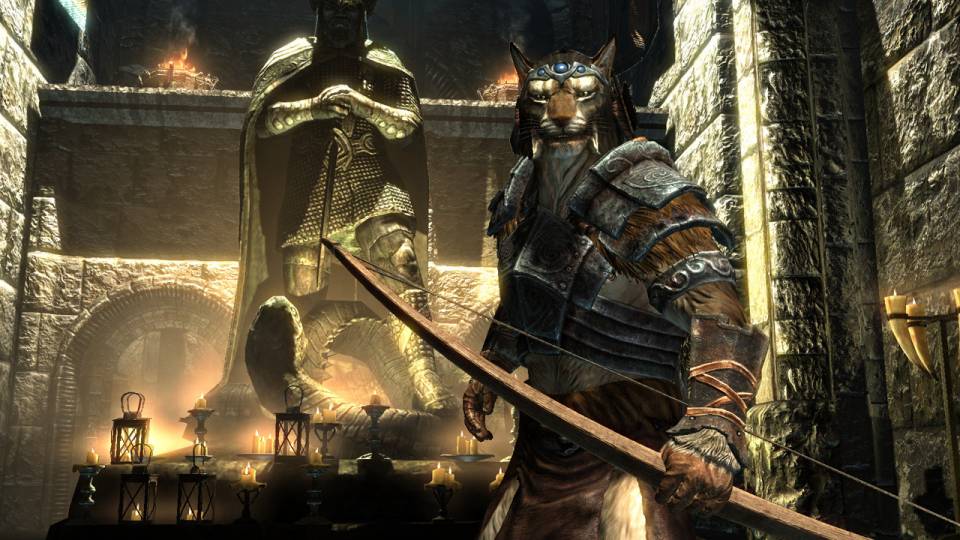
The Questing
Bethesda appears to be making a big effort to diversify the content and activities involved in Skyrim's quests. Before he even got to his destination, Howard's trek up the mountain involved squaring off against several ice trolls, hiding off the mountain path from a gigantic ice giant that was passing through, and using a befuddle spell to make two guards turn on and kill each other.
That was all before Howard breached the ancient catacombs where the thieves were hiding out and made his way through all manner of dank tunnels and musty tombs, fighting a bunch of zombie viking warriors, evading various booby traps, and squaring off against one hideously massive spider. The design of this dungeon was a little more intricate than most of the generic caves and ruins that you saw in Oblivion, though, with a couple of specific symbol-matching puzzles scattered here and there to test your noggin in addition to your sword.
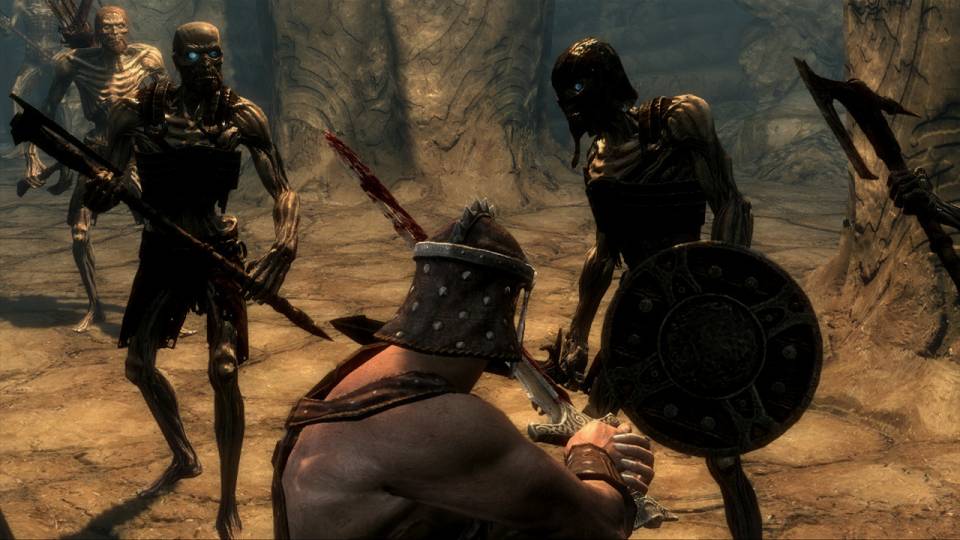
The Combat
Melee combat in Skyrim looks largely unchanged from Oblivion, in that you sort of bluntly hack at your opponent when you attack, though you will get scripted execution animations from time to time depending on how the fight is going. Blocking and bashing with shields also looks pretty familiar. The spell system, frankly, looks pretty awesome. You can assign spells to either hand, of course, but then you can combine them on the fly, almost Magicka-style. At one point Howard was using a sword with a heal spell in his off hand, then quickly switched his sword hand to the same heal spell, and you could see the character visibly channel the energies from each hand into a glowing orb that resulted in a massive health boost. In another instance, he put together a fire spell with an area-of-effect shockwave to add a fire effect to the radial blast. I didn't get a sense of how many different spells will be compatible with each other, but this looks like a pretty fun system to play around with.
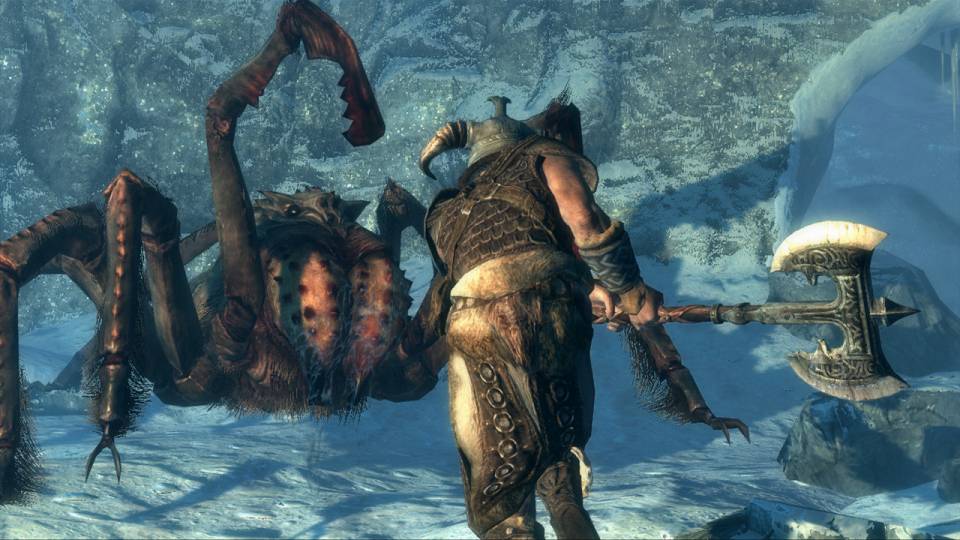
Plenty of the improvements made to Fallout 3 will make their way into Skyrim, of course. I bet you want to know about level scaling, right? Relax: it's like Fallout 3's, not like Oblivion's. That means enemies won't constantly level up with you throughout the game; instead, they'll operate at a fixed level based on when you encounter them on your own leveling progression. There's now no level cap, though Howard speculates that most people will max out around level 50, and the overall leveling speed has been increased to accommodate your progress through these levels.
Fallout-style perks are here in force, so as you level you'll be able to pick style-specific bonuses such as adding a bleeding damage-over-time effect to your axe attacks (which is the only perk Howard mentioned). Attributes have been significantly condensed down to simply strength, stamina, and magic, which Howard says will still trickle down into the same character buckets they did when you were managing more than double that many.
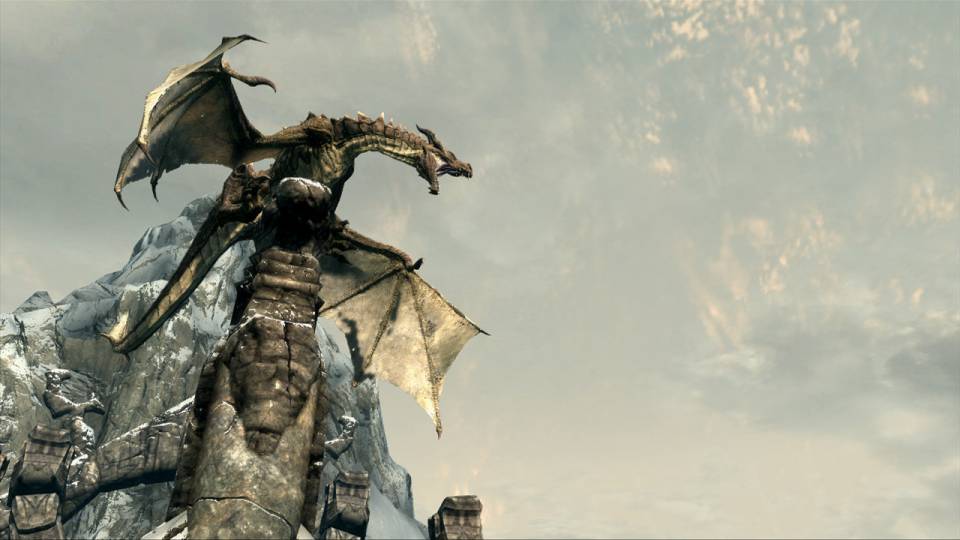
The Interface
Bethesda was showing Skyrim on the 360, so I can only speak to what the new interface is looking like on the consoles--and I can tell you that it looks highly streamlined to work on a gamepad. Pretty much every major game function--skills, magic, inventory, the map--can be accessed instantly from a pop-up radial menu that appears over the game world. You can also pop up hand-specific lists of weapons and spells to change what each hand is holding in a matter of seconds. The inventory list has been condensed and streamlined to let you scroll through more equipment more quickly than in Oblivion, and the team is emphasizing a 3D view of each item within the inventory that lets you examine all your gear in fine detail. This view will actually be necessary for gameplay reasons from time to time; that symbol-matching puzzle in the catacombs required the player to view the artifact you'd retrieved in the inventory up close to see which symbols he needed to use.

The Tech
For Skyrim, Bethesda has abandoned the old Gamebryo engine in favor of its own technology, though Howard was quick to point out that Gamebryo simply acted as the renderer (the part of the engine that handles processing and drawing graphics to the screen) in conjunction with all of the other game systems that the studio has built itself. In practice, the new game looks noticeably more detailed than Oblivion and Fallout 3, but it's not a generational leap or anything, at least on the 360. Bethesda didn't show the PC version of the game, but Howard noted it will use DirectX 9-level shaders, though you'll see a performance increase by running the game on a DX11 card.
Also, there is no Speedtree. Repeat: NO SPEEDTREE. Bethesda has built its own tree and foliage system. They look like pretty nice trees. Take that as you will.
